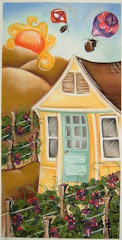 First off, I want to thank my friend Eric (an expat from France) and wine shop owner of Rouge Wine Cellar & Gifts in Creston Illinois for the inspiration and contribution to this post!
First off, I want to thank my friend Eric (an expat from France) and wine shop owner of Rouge Wine Cellar & Gifts in Creston Illinois for the inspiration and contribution to this post!Eric was recently given this bottle of wine that he became very excited about even though he had no intention of ever opening it. The following are bits and pieces quoted from Eric along with some of my own observations.
The wine inside is said to be a "White Bordeaux Wine" from the 1969 vintage, bottled by Cruse & Fils, Frères and imported by "the sole distributor for the US" The Jos. Garneau Co, NY.
Eric observed a dark tea-like shade for its color, so it's obviously past its prime and will never be opened; too bad, because it would have been fun to taste this wine while it was in its prime, because tasting it would have allowed us a chance at identifying it. As I elaborate further, the labeling of this wine is full of a lot of contradictions, making it impossible to ever know for sure what's inside.
The label clearly states that this is a Bordeaux wine (Appellation Bordeaux Controlée), however, the shape of the bottle suggests that it's Burgundian. To confuse matters even more, there is also a tiny inscription on the neck that actually reads "Bourgogne - Bordeaux". For those of you not familiar with French geography, Bordeaux is found along the west coast of France just south of center. Burgundy on the other hand is found north east of Bordeaux along the eastern center of the country.
To the best of our knowledge, Bordeaux producers have never used a Burgundy shaped bottle for their wines. This is important because the region defines the grape variety and the shape of the bottle used. To add one more possibility to the mix, despite what it says on the neck about it being a "Bourgogne - Bordeaux", the wine could have come from the Loire valley which was almost unheard of by Americans in 1969, and is closer to Bordeaux (due north) than Burgundy. Like Bordeaux, Loire also grows Sauvignon Blanc, however they bottle their wines in Burgundian shaped bottles.
Back in 1969, Americans were consuming more off-dry white wines (partially sweet) than those that were completely dry. Bordeaux is also known for these types of wines; however so is the Loire. There is also one more strange clue. The label also says "Blanc de Blancs Brut", which would imply that you are now expecting a sparkling Chardonnay! The cork and foil however are what you find on a still bottle of wine, not a sparkling one. So why the "Blanc de Blancs" title indicating only white grapes were used to produce this white wine? You wouldn't find either Chardonnay or the blending of white and red grapes in a Boardeaux white wine!
With this information, my best guess narrows down the grape varieties to the following: If the wines were completely dry then it could be a Sauvignon Blanc from the Loire or Chardonnay from Burgundy. If the wine were a little sweet then perhaps a French Columbard from the Loire Valley or possibly a Chenin Blanc from the Loire village of Vouvray.
After perusing the Internet for a possible explanation, Eric found this in a WSJ article:
 "Acting on an informant's tip, in June 1973, French tax inspectors barged into the offices of the 155-year-old Cruse et Fils Frères wine shippers. Eighteen men were eventually prosecuted by the French government, accused, among other things, of passing off humble wines from the Languedoc region as the noble and five-times-as-costly wine of Bordeaux. During the trial it came out that the Bordeaux wine merchants regularly defrauded foreigners."
"Acting on an informant's tip, in June 1973, French tax inspectors barged into the offices of the 155-year-old Cruse et Fils Frères wine shippers. Eighteen men were eventually prosecuted by the French government, accused, among other things, of passing off humble wines from the Languedoc region as the noble and five-times-as-costly wine of Bordeaux. During the trial it came out that the Bordeaux wine merchants regularly defrauded foreigners."It appears that around the same time this bottle was shipped to the US, the Cruse family was doing some shady blending between different wines from different regions, an absolute big "Non Non" in France, which could very well explain why there are so many contradicting elements to the labeling of this bottle. Today, it's amazing how obviously suspicious this bottle looks and yet somebody sold it and another bought it!
As Eric concludes, "I had only been drinking wine for 2 years in my baby bottles in 1969 but I bet I could have smelled the rat! I tell you my friends, don't trust the French when it comes to wine!"
And as one of Eric's French friends added "This is not fraud. This is great marketing. This bottle has all to attract all kinds of consumers: Burgundy amateur, Bordeaux collectors, White lovers and Sparkling drinkers. This is what one calls "to cover your bases." As for not trusting the French about wines: If on the sixth day God created Man and Woman on the seventh the French created wine fraud."
Cheers!
Jon








